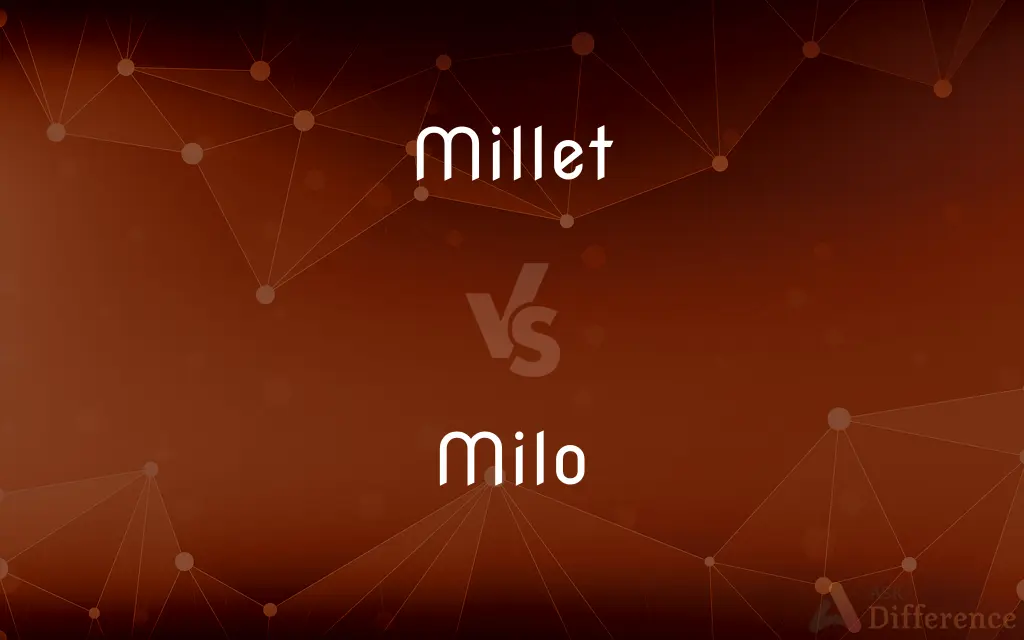Millet vs. Milo — What's the Difference?
By Tayyaba Rehman — Updated on October 4, 2023
Millet refers to small-seeded grasses, utilized as cereal in various cultures. Milo, often recognized as Sorghum bicolor, is primarily used for grain, fodder, and producing syrup, showcasing a more robust plant structure.

Difference Between Millet and Milo
Table of Contents
ADVERTISEMENT
Key Differences
Millet and Milo stand as crucial grains, predominantly utilized in various global agricultural practices, each bearing distinct characteristics and applications. Millet encompasses a group of small-seeded grasses, often hailed for its drought-resistant properties. Conversely, Milo, commonly known as sorghum, is a cereal grain known for its hearty, robust plant structure and multipurpose use, including grain production, fodder, and syrup extraction.
The nutritional value embedded within Millet and Milo differentiates them significantly. Millet is often praised for its gluten-free properties and rich nutrient profile, making it a beneficial inclusion in various diets. Contrarily, Milo, while also nutritious, is notably utilized in livestock feed and is a significant staple in certain regions due to its adaptability to arid conditions and versatile application in food and industrial products.
When exploring the agricultural perspective, Millet exhibits an adaptable nature, capable of thriving in less-than-ideal soil conditions, providing sustenance in various challenging environments. Milo, while also adaptable to harsher climates, particularly thrives in warm-temperature regions, often utilized not only for its grains but also as a significant source of fodder for livestock, thereby serving a dual purpose in agricultural practices.
Discussing culinary applications, Millet frequently finds itself included in various dishes, often ground into flour or cooked in a manner similar to rice, providing a versatile base in numerous culinary creations. Milo, while also consumed, may be more widely recognized in a commercial and industrial capacity, utilized in creating syrups, biofuel, and as a vital component in producing alcoholic beverages in certain cultures.
Delving into their global impact, Millet has historically been a staple in various cultures, especially in regions of Africa and Asia, where it has underpinned sustenance for populations for centuries. Milo, with its hearty and resilient nature, holds a substantial role in global agriculture, offering grains for consumption, providing livestock feed, and contributing to industrial processes, thereby establishing itself as a multifaceted crop in numerous regions.
ADVERTISEMENT
Comparison Chart
Classification
Small-seeded grasses
A cereal grain plant (Sorghum bicolor)
Utilization
Cereal, bird seed, and human consumption
Grain, fodder, syrup production, and brewing
Climate
Adapts well to dry and less fertile areas
Prefers warmer climates
Nutritional Use
Noted for being gluten-free and nutrient-rich
Valued for its hearty grain and versatility
Culinary Use
Versatile in various dishes and flour
Often used in syrups and industrial products
Compare with Definitions
Millet
A gluten-free grain, suitable for numerous culinary applications.
Millet flour is often used to create gluten-free bread and baked goods.
Milo
A crop known for its hearty structure and substantial stalk.
The robust stalks of Milo are often utilized as a source of fodder.
Millet
A nutrient-dense grain, providing various essential minerals and vitamins.
Millet can be a beneficial addition to salads, providing extra nutrients.
Milo
A cereal grain, also known as Sorghum bicolor, utilized for various purposes.
Milo can be used to produce grain, fodder, and even syrups.
Millet
A versatile grain, utilized in both human and bird diets.
Millet often features in bird seed mixes due to its nutritional content.
Milo
A robust plant, preferred for its resilience in warm and arid conditions.
Milo continues to yield crops even amidst challenging, dry climates.
Millet
Millets () are a group of highly variable small-seeded grasses, widely grown around the world as cereal crops or grains for fodder and human food. Millets are important crops in the semiarid tropics of Asia and Africa (especially in India, Mali, Nigeria, and Niger), with 97% of millet production in developing countries.
Milo
A multipurpose crop, finding usage in food, industry, and livestock feed.
Milo is frequently employed as a fundamental component in livestock diets.
Millet
Any of various annual grasses with small grains that are harvested for food, livestock feed, and birdseed, especially proso millet.
Milo
An industrial crop, used in producing biofuel and alcoholic beverages.
Milo is often fermented to produce sorghum beer in various regions.
Millet
A cereal grown in warm countries and regions with poor soils, bearing a large crop of small seeds which are chiefly used to make flour.
Milo
Any of various sorghums that are cultivated for their grain, which resembles millet. Also called grain sorghum.
Millet
The grains of any of these plants.
Milo
(US) sorghum
Millet
A demographic group in the Ottoman Empire, defined in terms of religious affiliation and enjoying a degree of legal autonomy.
Milo
Sorghum of a drought-resistant variety which is an important cereal in the central US.
Millet
Any of a group of various types of grass or its grains used as food, widely cultivated in the developing world.
Milo
Small drought-resistant sorghums having large yellow or whitish grains
Millet
(specifically) common millet, in particular Panicum miliaceum.
Millet
(historical) A semi-autonomous confessional community under the Ottoman Empire, especially a non-Muslim one.
Millet
The name of several cereal and forage grasses which bear an abundance of small roundish grains. The common millets of Germany and Southern Europe are Panicum miliaceum, and Setaria Italica.
Millet
Any of various small-grained annual cereal and forage grasses of the genera Panicum, Echinochloa, Setaria, Sorghum, and Eleusine
Millet
French painter of rural scenes (1814-1875)
Millet
Small seed of any of various annual cereal grasses especially Setaria italica
Millet
A type of small-seeded grass, commonly used as a cereal crop.
Millet has been a crucial staple in certain African countries for centuries.
Millet
A drought-resistant crop, capable of thriving in challenging environments.
Millet continues to provide crops even in dry, suboptimal conditions.
Common Curiosities
Is Millet gluten-free?
Yes, Millet is inherently gluten-free and often used in gluten-free recipes.
In what climates does Milo commonly thrive?
Milo typically thrives in warm and arid climates, showcasing robust resilience.
Can Millet grow in dry conditions?
Yes, Millet is known for its ability to grow in dry and less fertile conditions.
Is Millet nutritionally dense?
Yes, Millet is recognized for its rich nutrient content, including vitamins and minerals.
Is Millet beneficial for birds?
Absolutely, Millet is often a favored ingredient in birdseed due to its nutritional properties.
Are there different types of Milo?
Yes, there are several varieties of Milo, often differentiated by their intended use (grain, sweet, or forage sorghum).
What is Millet primarily used for?
Millet is commonly used as a cereal grain for human consumption and birdseed.
What are common uses for Milo?
Milo is utilized for grain production, livestock fodder, and creating syrup.
Is Milo a type of Millet?
No, Milo (or Sorghum) and Millet are distinct grains with different uses and characteristics.
What part of the Milo plant is used for fodder?
The robust stalks and leaves of the Milo plant are often used as livestock fodder.
Can Millet be used in brewing?
Yes, Millet is sometimes used to create alcoholic beverages, particularly in certain African cultures.
How is Millet typically consumed?
Millet can be eaten whole, ground into flour, or utilized in a variety of dishes.
What are the primary products derived from Milo?
Milo can be used to produce grain, syrup, biofuel, and is also used as fodder.
Is Milo suitable for human consumption?
Yes, Milo grains can be consumed and are also used to make various products like syrups and beverages.
What distinguishes Millet from Milo in appearance?
Millet grains are typically small and round, while Milo grains (sorghum) are usually larger and oval/round in shape.
Share Your Discovery

Previous Comparison
Excite vs. Agitate
Next Comparison
Meritorious vs. MaritoriousAuthor Spotlight
Written by
Tayyaba RehmanTayyaba Rehman is a distinguished writer, currently serving as a primary contributor to askdifference.com. As a researcher in semantics and etymology, Tayyaba's passion for the complexity of languages and their distinctions has found a perfect home on the platform. Tayyaba delves into the intricacies of language, distinguishing between commonly confused words and phrases, thereby providing clarity for readers worldwide.















































